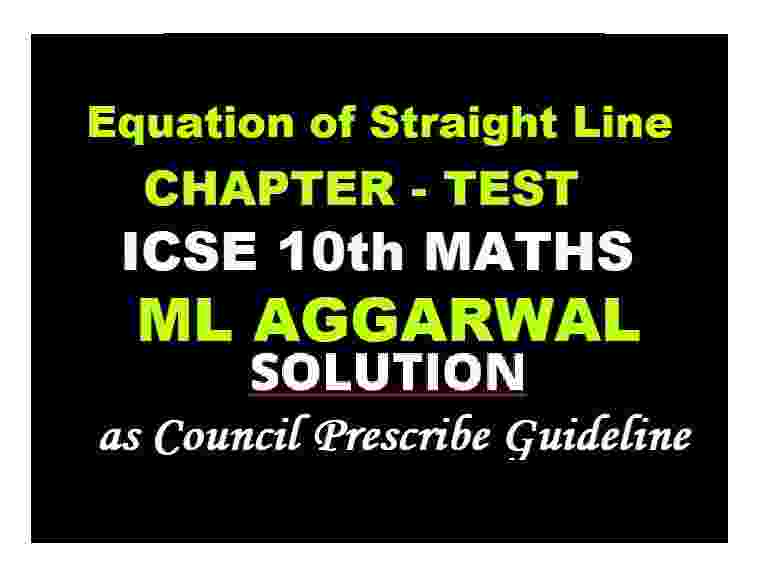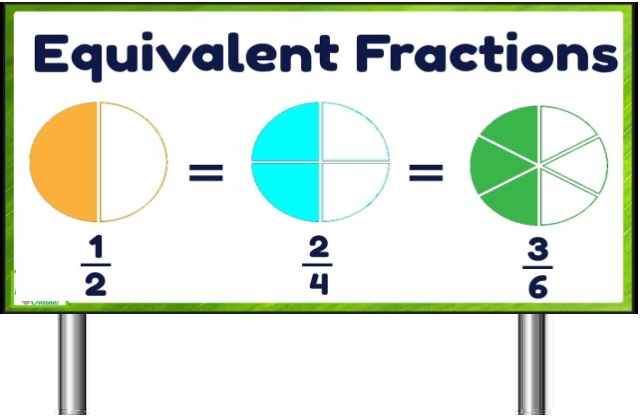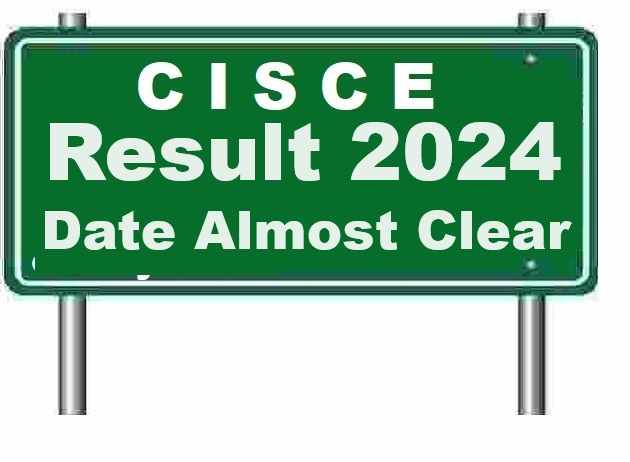ML Aggarwal Equation of Straight Line Ch-Test Class 10 ICSE Maths Solutions Ch-12. We Provide Step by Step Answer of Ch-Test Questions for Equation of Straight Line as council prescribe guideline for upcoming board exam. Visit official Website CISCE for detail information about ICSE Board Class-10.
ML Aggarwal Equation of Straight Line Ch-Test Class 10 ICSE Maths Solutions Ch-12
| Board | ICSE |
| Publications | Avichal Publishig Company (APC) |
| Subject | Maths |
| Class | 10th |
| Chapter-12 | Equation of Straight Line |
| Writer | ML Aggarwal |
| Book Name | Understanding |
| Topics | Solution of Ch-Test Questions |
| Edition | 2022-2023 |
Ch-12 Equation of Straight Line Ch-Test
ML Aggarwal Solutions of Class 10 for ICSE Maths
Page-249
Question- 1
Find the equation of a line whose inclination is 60° and y-intercept is – 4.
Answer- 1
Angle of inclination = 60°
Slope = tan θ = tan 60° = √3
Equation of the line will be,
y = mx + c = √3x + ( – 4)
⇒ y – √3x – 4
Question -2
Write down the gradient and the intercept on the y-axis of the line 3y + 2x = 12.
Answer- 2
Slope of the line 3y + 2x = 12
⇒ 3y = 12 – 2x
⇒ 3y = -2x + 12
y = (-2/3) x + 12/3
y = (-2/3) x + 4
Hence, gradient = -2/3 and the intercept on the y-axis is 4.
Question -3
If the equation of a line is y – √3x + 1, find its inclination.
Answer -3
In the line
y = √3 x + 1
Slope = √3
⇒ tan θ = √3
⇒ θ = 60° (∵ tan 60° = √3)
Question -4
If the line y = mx + c passes through the points (2, – 4) and ( – 3, 1), determine the values of m and c.
Answer- 4
The equation of line y = mx + c
∵ it passes through (2, – 4) and ( – 3, 1)
Now substituting the value of these points -4 = 2m + c …(i)
and 1 = -3m + c …(ii)
Subtracting we get,
-5 = 5m
⇒ m = -5/5 = -1
Substituting the value of m in (i)
-4 = 2(-1) + c
⇒ -4 = -2 + c
c = -4 + 2 = -2
∴ m = -1, c = -2
Question -5
If the point (1, 4), (3, – 2) and (p, – 5) lie on a line, find the value of p.
Answer- 5
Let the points to be A (1, 4), B (3, -2) and C (p, -5) are collinear and let B (3, -2)
divides AC in the ratio of m1 : m2
∴ x = (m1x2 + m2x1)/(m1 + m2)
⇒ 3 = (m1p + m2×1)/(m1 + m2)
3m1 + 3m2 = m1p + m2
⇒ 3m1 – m1p = m2 – 3m2
⇒ m1(3 – p) = -2 m2
⇒ m1/m2 = – 2/(3 – p) …(i)
and –2 = {m1(-5) + m2×4}/(m1 + m2)
⇒ -2m1 – 2m2 = – 5m1 + 4m2
⇒ -2m1 + 5m1 = 4 m2 + 2m2
⇒ 3m1 = 6 m2
⇒ m1/m2 = 6/3 = 2 …(ii)
From (i) and (ii)
-2/(3–p) = 2
⇒ -2 = 6 – 2p
⇒ 2p = 6 + 2 = 8
⇒ p = 8/2 = 4
Question- 6
Find the inclination of the line joining the points P (4, 0) and Q (7, 3).
Answer -6
Slope of the line joining the points P (4, 0) and Q (7, 3)
= (y2 – y1)/(x2 – x1) = (3–0)/(7–4) = 3/3 = 1
∴ tan θ = 1
⇒ θ = 45° (∵ tan 45° = 1)
Hence inclination of line = 45°
Question -7
Find the equation of the line passing through the point of intersection of the lines 2x + y = 5 and x – 2y = 5 and having y-intercept equal to -3/7
Answer -7
Equation of lines are
2x + y = 5 …(i)
x – 2y = 5 …(ii)
Multiply (i) by 2 and (ii) by 1, we get
4x + 2y = 10
x – 2y = 5
Adding we get,
5x = 15
⇒ x = 15/5 = 3
Substituting the values of x in (i)
2×3 + y = 5
⇒ 6 + y = 5
⇒ y = 5 – 6
= -1
∴ Co-ordinates of point of intersection are (3, -1)
∵ the line passes through (3, -1)
∴ -1 = m×3 – 3/7 (y = mx + c)
3m = -1 + 3/7 = -4/7
m = -4/(7×3)
= -4/21
∴ Equation of line y = -4/21 ×x – 3/7
⇒ 21y = -4x – 9
⇒ 4x + 21y + 9 = 0
Question -8
If the lines x/3 + y/4 = 7 and 3x + ky = 11 are perpendicular to each other, find the value of k.
Answer -8
Given Equation of lines are
x/3 + y/4 = 7
⇒ 4x + 3y = 84
⇒ 3y = -4x + 84
⇒ y = -4/3 ×x + 28 …(i)
And 3x + ky = 11
⇒ ky = -3x + 11
⇒ y = (-3/k)×x + 11/k …(ii)
Let slope of line (i) be m1 and of (ii) be m2
∴ m1 = -4/3 and m2 = -(3/k)
∵ These lines are perpendicular to each other
∴ m1m2 = – 1
⇒ -4/3 × (-3/k) = -1
⇒ 4/k = -1
⇒ – k = 4
⇒ k = – 4
Question -9
Write down the equation of a line parallel to x – 2y + 8 = 0 and passing through the point (1, 2).
Answer -9
The equation of the line is x – 2y + 8 = 0
⇒ 2y = x + 8
⇒ y = (1/2)×x + 4
∴ Slope of the line = 1/2
∴ Slope of the line parallel to the given line passing through (1, 2) = 1/2
∴ Equation of the lines will be,
y – y1 = m(x – x1)
⇒ y – 2 = 1/2 (x – 1)
⇒ 2y – 4 = x – 1
⇒ x – 2y – 1 + 4 = 0
⇒ x – 2y + 3 = 0
Question-10
Write down the equation of the line passing through ( – 3, 2) and perpendicular to the line 3y = 5 – x.
Answer-10
Equations of the line is
3y = 5 – x ⇒ 3y = -x + 5
⇒ y = -(1/3)×x + 5/3
∴ Slope of the line = -1/3
And slope of the line perpendicular to it and passing through (-3, 2) will be = 3
(∵ m1m2 = -1)
∴ Equation of the line will be
y – y1 = m(x – x1)
⇒ y – 2 = 3(x + 3)
⇒ y – 2 = 3x + 9
⇒ 3x – y + 9 + 2 = 0
⇒ 3x – y + 11 = 0
Question-11
Find the equation of the line perpendicular to the line joining the points A (1, 2) and B (6, 7) and passing through the point which divides the line segment AB in the ratio 3 : 2.
Answer-11
Let slope of the line joining the points A (1, 2) and B (6, 7) be m1
∴ m1 = (y2 – y1)/(x2 – x1)
= (7–2)/(6–1)
= 5/5
= 1
Let m2 be the slope of the line perpendicular to it then m1×m2 = -1
⇒ 1×m2 = -1
∴ m2 = -1
Let the point P (x, y) divides the line AB in the ratio of 3 : 2
∴ x = (m1x2 + m2x1)/(m1 + m2)
= {3×6 + 2×1)/(3 + 2)
= (18+2)/5
= 20/5
= 4
And y = (m1y2 + m2y1)/(m1 + m2)
= (3×7 + 2×2)/(3+2)
= (21+4)/5
= 25/5
= 5
∴ Co-ordinates of P will be (4, 5)
Now equation of the line passing through P and having slope –1
y – y1 = m(x – x1)
⇒ y – 5 = -1(x – 4)
⇒ y – 5 = -x + 4
⇒ x + y – 5 – 4 = 0
⇒ x + y – 9 = 0
Question-12
The points A (7, 3) and C (0, – 4) are two opposite vertices of a rhombus ABCD. Find the equation of the diagonal BD.
Answer-12
Slope of line AC (m1)
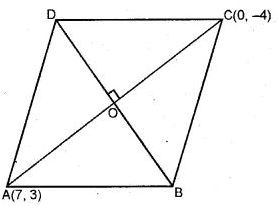
= (y2 – y1)/(x2 – x1)
= (-4 – 3)/(0 – 7)
= -7/-7
= 1
∵ Diagonals of a rhombus bisect each other at right angles
∴ BD is perpendicular to AC
∴ Slope of BD = -1 (∵ m1m2 = -1)
And co-ordinates of O, the mid-point of AC will be {(7 + 0)/2, (3 – 4)/2} or (7/2, -1/2)
∴ Equation of BD will be
y – y1 = m(x – x1)
⇒ y + 1/2 = -1 (x – 7/2)
⇒ y + 1/2 = -x + 7/2
⇒ 2y + 1 = -2x + 7
⇒ 2x + 2y + 1 – 7 = 0
⇒ 2x + 2y – 6 = 0
⇒ x + y – 3 = 0 (Dividing by 2)
Question-13
A straight line passes through P (2, 1) and cuts the axes in points A, B. If BP : PA = 3 : 1, find:
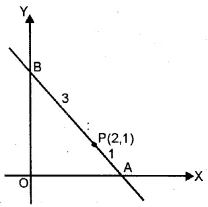
(i) the co-ordinates of A and B
(ii) the equation of the line AB
Answer-13
A lies on x-axis and B lies on y-axis
Let co-ordinates of A be (x, 0) and B be (0, y)
and P (2, 1) divides BA in the ratio 3 : 1.
∴ x = (m1x2 + m2x1)/(m1 + m2)
⇒ 2 = (3×x + 1×0)/(3+1)
⇒ 3x/4 = 2
⇒ 3x = 8
⇒ x = 8/3
And y = (m1y2 + m2y1)/(m1 + m2)
⇒ 1 = (3×0 + 1×y)/(3+1)
⇒ y/4 = 1
⇒ y = 4
∴ Co-ordinates of A will be (8/3, 0) and of B will be (0, 4)
(ii) Slope of the line AB = (y2 – y1)/(x2 – x1)
= (4 – 0)/(0 – 8/3)
= {4/(-8/3)}
= – 4 × 3/8
= -3/2
∴ Equation of AB will be
y – y1 = m(x – x1)
⇒ y – 1 = -3/2 (x – 2)
⇒ 2y – 2 = -3x + 6
⇒ 3x + 2y – 2 – 6 = 0
⇒ 3x + 2y – 8 = 0
Question-14
A straight line makes on the co-ordinates axes positive intercepts whose sum is 7. If the line passes through the point ( – 3, 8), find its equation.
Answer -14
Let the line make intercept a and b with the
x-axis and y-axis respectively then the line passes through
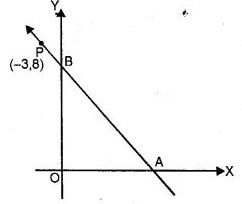
A (a, 0) and B (0, b)
But a + b = 7
b = 7 – a
Now slope of the line = (y2 – y1)/(x2 – x1)
= (b – 0)/(0 – a)
= -b/a
∴ Equation of the line y – y1 = m(x – x1)
⇒ y – 0 = (-b/a).(x – a) …(i)
∵ the line passes through the point (-3, 8)
∴ 8 – 0 = -b/a(- 3 – a)
= – {(7 – a)/a}×(-3 – a)
⇒ 8a = (7 – a)(3 + a)
⇒ 8a = 21 + 7a – 3a + a2
⇒ a2 + 8a – 7a + 3a – 21 = 0
⇒ a2 + 4a – 21 = 0
⇒ a2 + 7a – 3a – 21 = 0
⇒ a(a + 7) – 3(a + 7) = 0
⇒ (a + 7)(a – 3) = 0
Either a + 7 = 0, then a = -7, which is not possible as it is not positive
Or a – 3 = 0, then a = 3
and b = 7 – 3 = 4
∴ Equation of the line y – 0 = -(b/a)×(x – a)
⇒ y = -4/3(x – 3)
⇒ 3y = -4x + 12
⇒ 4x + 3y – 12 = 0
⇒ 4x + 3y = 12
Hence, the equation of the line is x3+y4=1 or 4x + 3y = 12
Question-15
If the coordinates of the vertex A of a square ABCD are (3, – 2) and the equation of diagonal BD is 3 x – 7 y + 6 = 0, find the equation of the diagonal AC. Also find the co-ordinates of the centre of the square.
Answer -15
Co-ordinates of A are (3, -2).
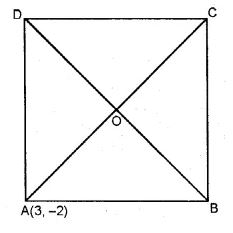
Diagonals AC and BD of the square ABCD
bisect each other at right angle at O.
∴ O is the mid-point of AC and BD Equation
Diagonals AC and BD of the square ABCD bisect each other at right angle at O.
∴ O is mid-point of AC and BD
Equation of BD is 3x – 7y + 6 = 0
⇒ 7y = 3x + 6
⇒ y = (3/7)×x + 6/7
∴ Slope of BD = 3/7
And slope of AC = -7/3 (∵ m1m2 = -1)
∴ Equation of AC will be
y – y1 = m(x – x1)
⇒ y + 2 = -7/3 (x – 3)
⇒ 3y + 6 = -7x + 21
⇒ 7x + 3y + 6 – 21 = 0
⇒ 7x + 3y – 15 = 0
Now we will find the co-ordinates of O, the points of intersection of AC and BD
We will solve the equations,
3x – 7y = – 6 …(i)
7x + 3y = 15 …(ii)
Multiplying (i) by 3 and (ii) by 7, we get,
9x – 21y = – 18 …(iii)
49x + 21y = 105 …(iv)
Adding we get,
58x = 87
⇒ x = 87/58 = 3/2
Substituting the value of x in (iii)
9(3/2) – 21y = – 18
⇒ 27/2 – 21y = – 18
21y = 27/2 + 18
= (27 + 36)/2
= 63/2
y = 63/(2×21)
= 3/2
∴ Co-ordinates of O will be (3/2, 3/2)
— : End ML Aggarwal Equation of Straight Line Ch-Test Class 10 ICSE :–
Return to :- ML Aggarwal Solutions for ICSE Class-10
Thanks
Please Share with Your Friends

